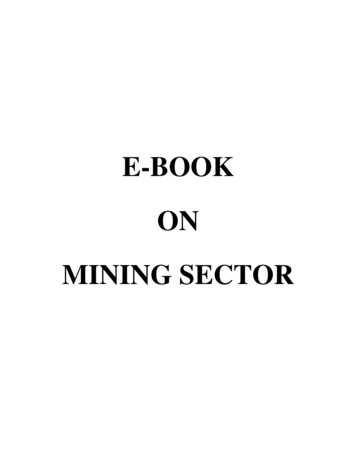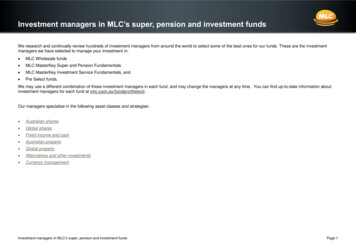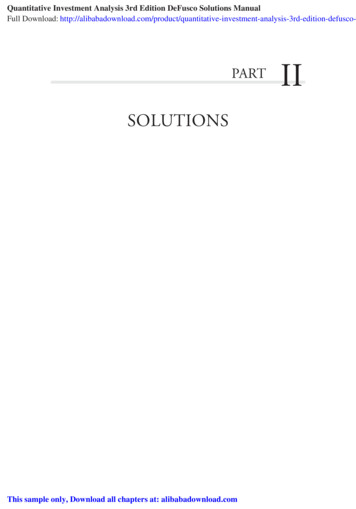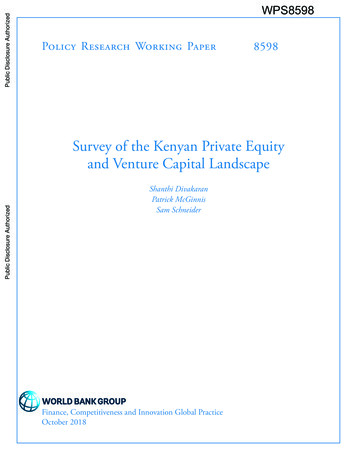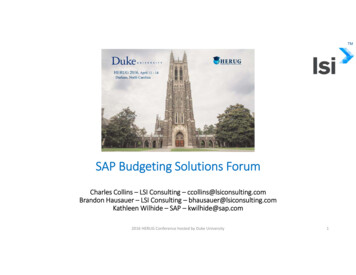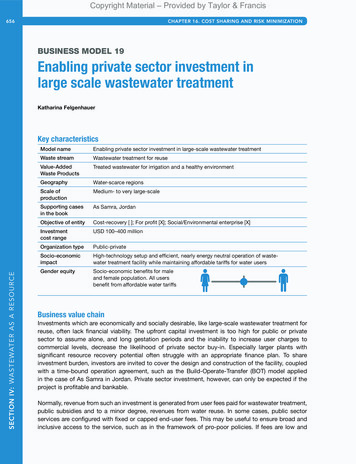
Transcription
Copyright Material – Provided by Taylor & Francis656CHAPTER 16. COST SHARING AND RISK MINIMIZATIONBUSINESS MODEL 19Enabling private sector investment inlarge scale wastewater treatmentKatharina FelgenhauerSECTION IV: WAS TEWATER AS A R ES OURCEKey characteristicsModel nameEnabling private sector investment in large-scale wastewater treatmentWaste streamWastewater treatment for reuseValue-AddedWaste ProductsTreated wastewater for irrigation and a healthy environmentGeographyWater-scarce regionsScale ofproductionMedium- to very large-scaleSupporting casesin the bookAs Samra, JordanObjective of entityCost-recovery [ ]; For profit [X]; Social/Environmental enterprise [X]Investmentcost rangeUSD 100–400 millionOrganization ogy setup and efficient, nearly energy neutral operation of wastewater treatment facility while maintaining affordable tariffs for water usersGender equitySocio-economic benefits for maleand female population. All usersbenefit from affordable water tariffsBusiness value chainInvestments which are economically and socially desirable, like large-scale wastewater treatment forreuse, often lack financial viability. The upfront capital investment is too high for public or privatesector to assume alone, and long gestation periods and the inability to increase user charges tocommercial levels, decrease the likelihood of private sector buy-in. Especially larger plants withsignificant resource recovery potential often struggle with an appropriate finance plan. To shareinvestment burden, investors are invited to cover the design and construction of the facility, coupledwith a time-bound operation agreement, such as the Build-Operate-Transfer (BOT) model appliedin the case of As Samra in Jordan. Private sector investment, however, can only be expected if theproject is profitable and bankable.Normally, revenue from such an investment is generated from user fees paid for wastewater treatment,public subsidies and to a minor degree, revenues from water reuse. In some cases, public sectorservices are configured with fixed or capped end-user fees. This may be useful to ensure broad andinclusive access to the service, such as in the framework of pro-poor policies. If fees are low and
Copyright Material – Provided by Taylor & FrancisBUSINESS MODEL 19: PRIVATE SECTOR INVESTMENT AT SCALE657inflexible, the costs for infrastructure installation plus operation and maintenance is hardly recoveredfully through user fees, let alone can a profit be made from the operation.To address this common situation, the business concept applied in As Samra suggests ways to providean attractive investment opportunity to private sector despite inflexible user fees and high capitalcosts. Government or donor funds can be used to cover up-front capital expenditure in infrastructure,thereby setting the stage for private investors. Such targeted investment of public sector funds cansecure private sector resources in the forms of funding, material assets, technology and managementexpertise.Public investment thereby achieves higher impact at a faster and more efficient rate comparedto a solely public intervention. After a defined period of operation, the facility can be handed back togovernment, providing a return in kind on the initial public expenditure. Private sector managementensures a resource-efficient setup and running of the operation, giving the public sector opportunityto continue efficient service provision after the end of the public-private partnership (PPP) agreement.High degrees of energy recovery for system internal reuse is supporting the feasibility of the model.To achieve this leverage, the upfront investment costs of the overall undertaking must be reducedto a level that makes the venture interesting and viable for private sector investors, including banks.A comprehensive risk management and reassurance scheme has to accompany and guide thepartnership to ensure adherence to resource commitment by all parties throughout the duration of thePPP term.Business modelPublic sector funds have to be available for this model to close the funding gap, either through domesticgovernment budget or other sources, e.g. international development partners. Funds should be disbursedas grants to reduce financial liability. These funds are used to cover all or some initial infrastructureinvestment costs to reduce the up-front investment hurdle (Viability Gap Funding, see Box 10).The funds should not subsidize the companies themselves nor their operations but the infrastructuredevelopment at hand; companies will earn a return only on their share of investment. Investorscan create a project company, in which different sponsors can hold shares, to ease transactionmanagement and tracking. Benefits can be combined with existing measures which attract foreigndirect investment, such as tax breaks or reduction of duties and levies.The private sector co-funding can only be secured if the viability gap funding has been fully committedto. Guarantee mechanisms have to be in place to back the commitments, e.g. through comprehensivecontracts (see example in Figure 237) and guarantees from government or multilateral bodies. Backingby the Ministry of Finance (e.g. through a reserve fund) as well as international reinsurance and disputeresolution services help build trust among the partners and lower the investment risk. In the case ofAs Samra, Jordan, the Multilateral Investment Guarantee Agency (MIGA) provided guarantees againstbreach of contract for the expansion of the plant and its operation during the 20 year PPP term (MIGA,2015). Failure to comply with any commitment should lead to strict and clearly spelled out penalties,SECTION IV: WAS TEWATER AS A R ES OURCEThis business model looks at blended finance options for the up-front investment of medium- tolarge-scale wastewater treatment plants. The model seeks to attract private sector co-funding and isapplicable to situations in which the water user fees cannot fully recover investment, operating andmaintenance costs. By reducing the up-front investment needs, the venture becomes financiallyinteresting for private investors.
Copyright Material – Provided by Taylor & Francis658CHAPTER 16. COST SHARING AND RISK MINIMIZATIONBox 10. Viability Gap FundingViability Gap Funding (VGF) refers to a grant, one-time or deferred, provided to support infrastructureprojects that are economically justified but fall short of financial viability. The lack of financialviability usually arises from long gestation periods and the inability to increase user charges tocommercial levels, making it unattractive for private sector investments. Viability Gap Funding(VGF) reduces the upfront capital costs of pro-poor private infrastructure investments by providinggrant funding at the time of financial close, which can be used during construction. The VGF ‘gap’is between the revenues needed to make a project commercially viable and the revenues likelyto be generated by user fees paid mostly by poor customers. Although the economic benefits ofa private investment project may be high, in situations where the incomes of end users are low,it may not be possible to collect sufficient user fees to cover costs. VGF is designed to makeprojects that are economically viable over the long term, commercially viable for investors. Ithelps mobilize private sector investment for development projects, while ensuring that the privatesector accepts a share in the risks of infrastructure delivery and operation. Recognized by severalinternational financial organizations the As Samra innovative financing has set up a new templatefor Viability Gap Financing. This new mechanism provides a significant leverage to the financialassistance of international donors and will allow new projects to materialize.FIGURE 237. SAMPLE CONTRACTUAL LANDSCAPE BASED ON THE CASE OF THE AS SAMRAPLANT, JORDANSECTION IV: WAS TEWATER AS A R ES ONSORSLENDERSConfirmationlettersSource: Adapted from SPC, 2014.
Copyright Material – Provided by Taylor & FrancisBUSINESS MODEL 19: PRIVATE SECTOR INVESTMENT AT SCALE659compensation or other rectification measures for all negligent parties. Banks are more likely to availcredit to private sector partners with a substantive risk-sharing mechanism in place.For such a setup with multiple actors and a high level of interdependency to work, a number offramework conditions need to be fulfilled (OECD, 2014). Government requires strong and stableinstitutions with growing capacity to manage private sector partners. In Jordan, the MillenniumChallenge Corporation (MCC, 2012) funded transaction advisors who would help broker the multiparty agreement system on behalf of the government. Unclear roles and responsibilities, ongoingreforms and policy gaps all contribute to a higher level of uncertainty, i.e. investment risk. The lessflexible the water tariffs, the more reliable the government commitment to maintain minimum pricesmust be. Otherwise, cost recovery risks become difficult for the investor to hedge. Partners need to beaware that negotiations are likely to take considerable time before completion; project implementationwill not commence before closure. These transaction costs add to the overall financial burden of theinvestment opportunity.In return, government investment leverages private co-funding for a timely setup and operation ofwastewater treatment to benefit large portions of society. Making additional water resources availablefor use in agriculture and industry supports economic development while maintaining affordable wateruser tariffs. At the end of the PPP agreement, government will receive the wastewater treatment facilityat no additional cost. Efficient management processes will be in place, spurred by private sectorinterest in efficiency gains during the PPP term.Alternate scenarioLower viability gap funding through tenderDifficulties might arise when calculating the dimension of viability gap funding needed to make theventure interesting to private investors. Cost recovery alone will be insufficient to entice investors whoare looking to make maximum profit. Investors, for the same reason, are motivated to predict inflatedcost estimates when asked for advice in calculating the appropriate viability gap funding.One way to limit the risk of overspending at the onset is to include the viability gap funding as elementin a public tender. Expressions of interest from private sector partners should include an assessmentof the amount of grant funding needed. The tender can then be allocated to the best bidder in terms ofservice provision and viability gap funding necessary to ensure maximum return on the public sectorgrant. The competitive nature of the bidding process encourages minimum gap funding requests.Service delivery quality, however, should not be compromised.SECTION IV: WAS TEWATER AS A R ES OURCEOnce operational, the treatment plant can generate revenue from government payment or user feesfor both, wastewater treatment and reuse of treated wastewater (Figure 238). If government steps in,expenses can partly be recovered through water fees or taxes at household or entity level. Farmersand companies which use treated water can be charged, however, fees will likely remain below thelevel of fresh water. A differentiated assessment of the clients’ willingness and capacity to pay willestimate the cost recovery potential of this revenue stream. Ideally, tariffs should be calculated tocover at least operation and maintenance of the wastewater treatment facility to ensure long-termviability even after the end of the PPP agreement. Flexible tariff structures reduce the economic riskof the investment.
Copyright Material – Provided by Taylor & Francis660CHAPTER 16. COST SHARING AND RISK MINIMIZATIONFIGURE 238. BUSINESS MODEL CANVAS – ENABLING PRIVATE SECTOR INVESTMENT IN OPOSITIONSCUSTOMERRELATIONSHIPSCUSTOMERSEGMENTS Sector ministry Secure viabilitygap fundingand revenueguarantee To createattractivebusinessopportunities forprivate sectorinvestment inwastewatertreatmentinfrastructure Public-privatepartnershipagreementPrivate sector withstrong track recordin wastewatertreatment, incl. Ministry ofFinance Donor(s) Privateinvestor(s) /operator(s) Commercialbanks Risk mitigationbroker / insurer Negotiateeffective riskmanagementand insurancemechanisms Price guarantee Riskmanagement andmitigation system Grant funding(government ordonor funds) Budget forpayment tooperators per m3of treated water Operators Commercialbanks / investors Moderate multipartner platformKEYRESOURCES InfrastructurecompaniesCHANNELS Multilateralnegotiations Mutual riskmanagementguarantees Public-privatepartnershipagreementSECTION IV: WAS TEWATER AS A R ES OURCE Risk insuranceCOST STRUCTUREREVENUE STREAMS Capital investment (one-time grant) Water user fees for wastewater and water reuse Payment to operators per m3 of treated water(ongoing expenses during PPP term) Government budget allocation and/or donor funds High degree of energy recovery as cost saving measure P-recovery as cost saving measure and possible revenueSOCIAL & ENVIRONMENTAL COSTSSOCIAL & ENVIRONMENTAL BENEFITS Large-scale treatment plant tooccupy land and eco-system Business-run operation will generate efficiencygains, i.e. save resources at high output,like low external energy requirements Sludge storage Private sector funds increase scope and impact ofoperation, i.e. more water is treated and availablefor reuse, reducing e.g. groundwater abstractionPotential risks and mitigationThis business model has been derived from the successful and acclaimed example of the As SamraPlant in Jordan. In addition to general risks related to reuse projects involving wastewater, such asharm to human and environmental health, the following risk mitigation options are particularly relevantto the financing model at hand.
Copyright Material – Provided by Taylor & FrancisBUSINESS MODEL 19: PRIVATE SECTOR INVESTMENT AT SCALE661Market risks: The viability gap funding requires a careful analysis of the business case for wastewatertreatment in the region. Without reliable calculations of cost recovery and attractive profit margins,public overspent is likely. The risk can be partly mitigated by including an assessment of necessaryviability gap funding in tender selection criteria (see alternate scenario above).The careful assessment of the business case for wastewater treatment will also help to ensure longterm sustainability of the operation, in particular upon handover of the facility back to government atthe end of the PPP. Water users’ fees, as sole income to refinance the service, must cover operationand maintenance costs of the facility to avoid continuous subsidy. A differentiated fee structure forusers of treated water, e.g. in agriculture or industry, can expedite cost recovery.Private sector investors will only buy into the venture if viability gap funding is fully committed. Acomprehensive risk-sharing and mitigation mechanism has to be negotiated for all parties to agree.This, in return, also provides security to government that public funds will effectively leverage additionalinvestment and result in efficient wastewater service delivery. Sufficient time and resources need tobe spent on the partnership negotiations and the establishment of a reliable contractual framework.Technology performance risks: Leveraging private sector investment supports high-end technologybecause companies will operate at competitive levels to sustain their own business and generate profit,e.g. through efficiency gains. At the end of the PPP agreement, public sector is likely to receive state-of-theart facilities. However, private sector partners must be selected competitively, considering track recordsof service delivery, to avoid technology and funding pitfalls. Quality of service should be guaranteed inunambiguous commitments (contracts) with clear remedy processes in case of non-compliance.Social equity related risks: The model enables social benefits independent from gender differentiation,such as increased water resources for agricultural and industrial production. Additional jobs will becreated at the plant (likely to favour male over female employees) as well as in irrigated agriculturebenefitting both gender. The model facilitates the preservation of low water user fees, thus supportingbroad and inclusive access to wastewater treatment services across social layers and income groups.Safety, environmental and health risks: The model is about balancing financial risks for large-scaleinvestments and as such not associated with any technology or particular environmental and healthrisks. In fact the financial volume is so high that it allows advanced treatment and risk mitigation.Naturally, the construction of a large-scale wastewater treatment plant will impact the site itself andits immediate surroundings, including eco-systems and communities. However, the downstreamenvironmental benefits are significant in terms of preventing pollution, and providing large amountsof reclaimed water. The involvement of private companies in setup and operation of the wastewatertreatment plant will support resource-efficient technology and management practices, e.g. coveringthe energy needs of production from own operation, and phosphorus recovery for reuse. In case ofnon-compliance with safety measures, potential health hazards will remain possible and demand riskmitigation measures as shown in Table 51 of Business Model 17. However, as this model is about theinstitutional–financial set-up, independently of the technology, a separate table on potential risksand risk mitigation has been omitted.SECTION IV: WAS TEWATER AS A R ES OURCEPolitical and regulatory risks: The model’s dependency on reliable funding commitments and risksharing entails heightened relevance of political and regulatory stability. Reinsurance guarantees haveto be given by stable, legitimate partners that are very likely to remain unchanged throughout theduration of the PPP agreement. A multi-layer support system which includes, for example, nationaland international partners alike, can be beneficial.
Copyright Material – Provided by Taylor & Francis662CHAPTER 16. COST SHARING AND RISK MINIMIZATIONBusiness performanceTargeted viability gap funding by public sector helps leap ahead in wastewater treatment and waterservice delivery. Government and donor grants can leverage funding from private investors whiletapping into business technology and expertise in wastewater treatment and management. Overallefficiency gains in water treatment (e.g. via energy recovery) coupled with the provision of additionalwater resources for agricultural or industrial consumption make the investment model attractiveto government. While private sector partners exploit a profitable business opportunity, returns ineconomic development and environmental protection benefit society at large. Figure 239 shows theranking of the model with its considerable strength to secure the anticipated positive environmentaland social impacts as well as long-term viability.That being said, the model can be challenging to set up with high transaction costs before operationscan begin. Commitments need to be reliably secured through contracts and effective remedymechanisms. Risk management and mitigation are of great importance, especially in large-scale andlong-term ventures, as the model is vulnerable to economic, political and regulatory instability. If thecapacity to effectively broker powerful public-private partnerships is further developed, substantialgains can be achieved in public service delivery.FIGURE 239 RANKING RESULTS FOR BUSINESS MODEL 19PROFITABILITY/COST RECOVERY32SECTION IV: WAS TEWATER AS A R ES OURCEINNOVATIONSOCIAL IMPACT1SCALABILITY ANDREPLICABILITYENVIRONMENTALIMPACT
Copyright Material – Provided by Taylor & FrancisBUSINESS MODEL 19: PRIVATE SECTOR INVESTMENT AT SCALE663References and further readingsKeenan, R. and Norman, M. 2012. As-Samra sets expansion template. Project Finance InternationalOctober 17: 48–51.MCC. 2012. MCC completes first major build-operate-transfer project financing in Jordan. 11 September,2012. MCC. nsfer-project.pdf (or https://goo.gl/LyRoH8; accessed 6 Nov. 2017).MIGA. 2015. Guaranteeing investments in water and sanitation projects. MIGABrief Water July 2015.OECD. 2014. Jordan: Overcoming the governance challenges to private sector participation in thewater sector. 10th meeting of the Regulatory Policy Committee, 14–15 April 2014, GOV/RPC/NER(2014)5.SPC. 2014. Samra: Wastewater treatment plant – A major asset for Jordan. Presentation 21 Oct, uments/2014/water and sanitation October/Jordan the Amman wastewater treatment plant.pdf (or https://goo.gl/mi3VNY; accessed 6Nov. 2017).SECTION IV: WAS TEWATER AS A R ES OURCEWichelns, D., Drechsel, P. and Qadir, M. 2015. Wastewater: Economic asset in an urbanizing world.In: Drechsel, P., Qadir, M. and Wichelns, D. (eds. Wastewater: Economic asset in an urbanizingworld. Dordrecht, Netherlands: Springer, pp. 3–14.
Copyright Material – Provided by Taylor & Francis17. BUSINESS MODELSON RURAL–URBANWATER TRADING
Copyright Material – Provided by Taylor & FrancisINTRODUCTION665IntroductionTo sustain increasing urban water demands different strategies are common, such as a combinationof long-distance water transfer and advanced wastewater treatment for reuse. Where possible alsoseawater desalination is being considered. Commonly referenced examples of technical excellenceare the production of potable water from wastewater in Singapore and Namibia, based on a businessmodel that is largely depending on reliable technology and positive public perceptions (Lazarovaet al., 2013).In this section, two business models (20 and 21) are presented which use a different approach ofexchanging wastewater and freshwater, based on rural-urban water trading. Compared with interbasin water transfers1, the here presented models target inter-sectoral transfers of water to uses ofhigher economic value:i)Water relocation takes place within the same basin or even the same watershed, moving wateroriginally allocated to agriculture to domestic use, in particular drinking water.ii) The models involve a two-way flow, i.e. freshwater release and transfer are based on the availabilityof a return flow of (treated) wastewater able to replace the created water gap and support if neededalso other ecosystem service functions.iii) Aquifer recharge is a common element complementing the available treatment capacity to producewater suitable for agricultural and/or domestic reuse also where treatment capacities are limited.Given the young age of the presented cases and complexity of their setup, financial performanceindicators as well as estimates of the social and/or environmental benefits or costs are largely missing,except for managed aquifer recharge, e.g. in USA or Australia (Maliva, 2014; Megdal et al., 2014; Gaoet al., 2014).Water exchange is driven by social and economic values. Not all uses of water are equally valued.Water for drinking has much high social value than for agriculture, yet the quantities involved aresmaller. Water for irrigation has a lower economic value but the quantities involved are vast; on aglobal average about 70% of all the world’s freshwater withdrawals go towards irrigation. Further, thequality requirements for drinking and agriculture are quite distinct. Therefore, taking a small volume ofgood quality water away from agriculture could make a sterling contribution to urban drinking waterneeds, while the resulting reduction to agriculture could be offset by substituting the lost amountwith reclaimed water of lower but still appropriate quality, and this independent of seasons, i.e.throughout the year (Figure 240). In instances where farmers can get volumetrically more reclaimedwater for irrigation than they release freshwater, and where a water-short municipality gets in a costcompetitive way a reliable supply of quality water for drinking, all partners benefit. Although suchwater exchange is in theory optimizing the value of the available water within a system, in supportof greater environmental sustainability and climate change adaptation, it requires incentive systemsand well-formulated contracts to secure the buy-in of a sufficiently large number of farmers whorelease freshwater for a mutually beneficial and thus sustainable business model. This is no easyendeavour with a range of possible gains but also conflicts (Molle and Berkoff, 2006; GWI, 2010),and might not recover its costs as long as swapped water volumes are low, but will greatly pay offin comparison with the direct and indirect costs of any extended drought period (Martin-Ortegaet al., 2012).SECTION IV: WAS TEWATER AS A R ES OURCEModel 20: Inter-sectoral water exchange
Copyright Material – Provided by Taylor & Francis666CHAPTER 17. RURAL–URBAN WATER TRADINGFIGURE 240. BASIC IDEA OF AN INTER-SECTORAL WATER ECTION IV: WAS TEWATER AS A R ES OURCEFRESHWATERSource: GWI, 2010, modifiedThe two case studies, which informed Business Model 20, are from Iran and Spain and based on themost recent experience with inter-sectoral water exchange. In the case of the Llobregat delta in Spain,a severe drought in 2007–2008 catalyzed significant investments into infrastructure able to producehigh-quality reclaimed water to secure farmers’ acceptance of a water swap in prolonged periods ofdrought. For this, the water swap contract remained flexible to allow transfers as needed. In Iran, onthe other hand, the urban water deficit of the city of Mashhad is common reality and farmers receivedincentives to transfer their (entire) freshwater rights to the city in exchange of treated wastewater. Bothcases face challenges which provide valuable lessons.The model offers several related value propositions:s Mitigating drought and related economic costs through reallocating freshwater from agricultureto urban use in exchange for reclaimed water allowing to realign water supply and demand fromvarious sectors based on sector specific water quality requirements.s Improved crop production and food security across seasons, the support of ecosystem services,aquifer recharge and increased resilience against drought and climate variability.s Opportunities to raise revenue from sale of freshwater for high-value use and enhancing costeffectiveness of the overall rural-urban water systems.
Copyright Material – Provided by Taylor & FrancisINTRODUCTION667Although a water exchange could be approached from the perspective of both main parties, the realityis that in most cases the urban end is the driver of the business. In the case of Iran, for example, aninitial survey showed that all city dwellers supported the planned exchange while about 97% of waterright holding farmers opposed the plan (Yazdi, 2011). While in this case the political power of the urbansector determined the negotiations, the opposite could be possible, like in the case of Faisalabad,Pakistan (Business Model 23) where farmers strongly prefer (untreated) wastewater instead of (the onlytemporarily available and nutrient-poor) freshwater.Model 21: Cities as their own downstream userThe chosen examples in this book are thus not success stories per se (Lazarova et al., 2013) withalready documented, positive benefit cost ratio (e.g. Vanderzalm et al., 2015; Perrone and MerriRohde, 2016), but reflecting situations and challenges observed on the trajectory to a more plannedand managed RRR program, which have a significant potential for upscaling, if appropriatelyaddressed.Common related challenges in developing countries are weak institutional linkages for integratedsurface and groundwater management across rural-urban borders, as well as missing regulations andmonitoring of water quality (Bahri, 2012; Foster and Vairavamoorthy, 2013; Yuan et al., 2016). Withoutenabling environment, related business models struggle although the economic benefits appear worththe investment. The two cases, which informed Model 21, are from Mexico and India. In the examplefrom Bangalore, India, largely untreated wastewater is transferred out of town to replenish periurban water tanks (reservoirs) and aquifers with multiple benefits for society, farming and ecosystemservices. Some of the water returns through informal water markets back to the city, often at pricesunaffordable for poorer households. Such rural–urban water transactions are increasingly commonaround Bangalore and many other cities in India, and need much stronger official acknowledgementto address likely externalities (Londhe et al., 2004).The second case is the Mezquital Valley of Mexico, which is well-known for its enormous scale ofwastewater reuse (Jiménez, 2009). With the recent inauguration of the Atotonilco treatment plant,the recovery of ‘freshwater’ from the replenished aquifer can become for Mexico City an increasinglyimportant business model with lower pumping costs than any alternative option. The two businesscases offer:SECTION IV: WAS TEWATER AS A R ES OURCEThe rapid growth in urban population in countries like India is putting immense pressure on urbanwater supply and wastewater management. This has led to large-scale water transaction betweenurban and peri-urban areas. On one hand, urban water authorities and informal water traders areincreasingly importing water from the urban periphery to meet the urban water need, while on otherhand, farmers in the hinterland are using wastewater disposed
thereby setting the stage for private investors. Such targeted investment of public sector funds can secure private sector resources in the forms of funding, material assets, technology and management expertise. Public investment thereby achieves higher impact at a faster and mor


